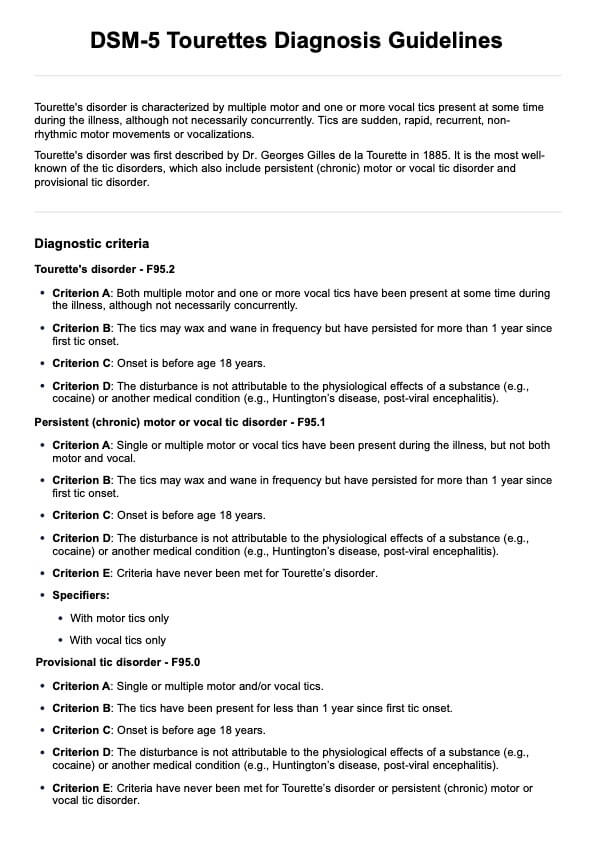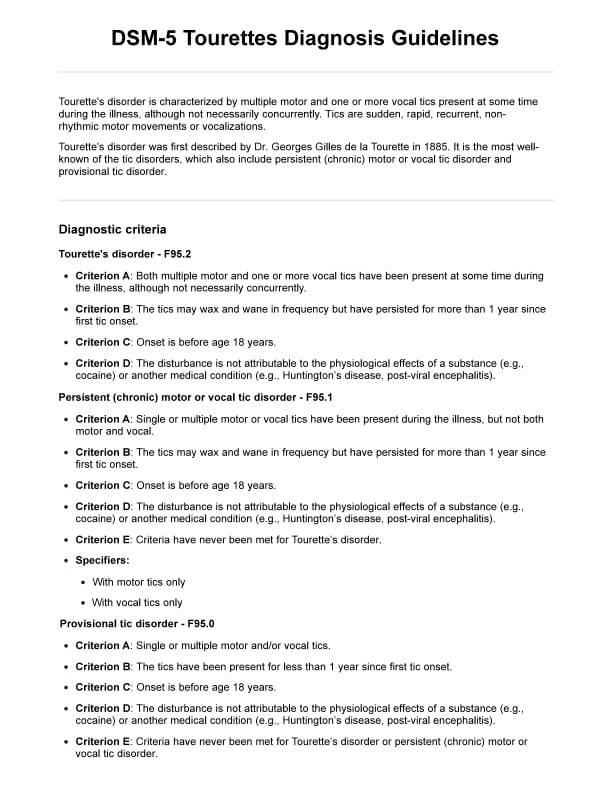DSM-5 Tourettes Diagnosis Guidelines
Learn about DSM-5 guidelines for diagnosing Tourette's Syndrome, including criteria, treatment options, and support. Use our template for easy reference.


What is Tourette's syndrome?
Tourette's syndrome (also previously known as Tourette's disorder) is a neurological disorder characterized by multiple motor and vocal tics that have been present for more than a year (American Psychiatric Association, 2022). Tics are sudden, rapid, recurrent, non-rhythmic abnormal movements or vocalizations. They often come with a feeling of mounting inner tension or urge, known as a premonitory urge, which is temporarily relieved by the tic.
Dr. Georges Gilles de la Tourette, a French neurologist, first described Tourette's Syndrome in 1885. Over time, it has become the most well-known of tic disorders, which also include persistent (chronic) motor or vocal tic disorder and provisional tic disorder. These disorders are classified based on tic severity, which considers the type and duration of tics.
- Simple tics: Short duration (milliseconds), such as eye blinking or throat clearing.
- Complex tics: Longer duration (seconds) and involve combinations of movements or sounds, such as simultaneous head turning and shoulder shrugging or uttering phrases.
Although tics can involve any muscle group or vocalization, they are more commonly associated with some muscle groups and certain sounds or turns of phrase. While tics are generally experienced as involuntary, many individuals can temporarily suppress them.
DSM-5 Tourettes Diagnosis Guidelines Template
DSM-5 Tourettes Diagnosis Guidelines Example
How is Tourette's disorder diagnosed?
Diagnosing Tourette's Disorder involves a comprehensive evaluation by a healthcare professional. Here are the steps involved:
- Clinical interview: Gathering detailed medical and family history.
- Observation: Assessing the types and frequency of tics through direct observation during a consultation. This part also includes gathering behavioral reports from teachers, family members, and other individuals in the patient's different environments.
- Criteria evaluation: Using the DSM-5 criteria to confirm diagnosis. To see all the criteria for all tic disorders, look at our template.
- Differential diagnosis: Ruling out other conditions that mimic tics, such as substance-induced tics or other neurological disorders. The neurological disorders that could mimic Tourette syndrome include stereotypic movement disorder, obsessive-compulsive disorder (OCD), Huntington’s disease, post-viral encephalitis, chorea, dystonia, myoclonus, and other functional movement disorders.
- Additional assessments: Other tests, such as laboratory tests (blood tests and neuroimaging), and neuropsychological testing, are done to evaluate cognitive and psychological functioning, especially if there are concerns about co-occurring conditions like attention deficit hyperactivity disorder (ADHD) or learning disabilities.
Tic disorders follow a hierarchical order. Once a higher-level tic disorder (e.g., Tourette's disorder) is diagnosed, lower-level diagnoses (e.g., Provisional tic disorder or other tic disorders) cannot be made. Here's how that looks:
- Tourette’s synrome (highest)
- Persistent (chronic) motor or vocal tic disorder (also known as chronic tic disorder)
- Provisional tic disorder
- Other specified and unspecified tic disorders (lowest)
DSM-5 diagnosis criteria for Tourette's
The DSM-5 diagnostic criteria for Tourette's Disorder are as follows:
- Criterion A: Both multiple motor and one or more vocal tics have been present at some time during the illness, although not necessarily concurrently.
- Criterion B: The tics may wax and wane in frequency but have persisted for more than 1 year since first tic onset.
- Criterion C: Onset is before age 18 years.
- Criterion D: The disturbance is not attributable to the physiological effects of a substance (e.g., cocaine) or another medical condition (e.g., Huntington’s disease, post-viral encephalitis).
The lower-level diagnoses each have their own set of diagnosis criteria.
Differences between DSM-4 and DSM-5 criteria
The diagnostic criteria for Tourette's Syndrome have been updated from DSM-IV to DSM-5 to better reflect the disorder's characteristics and align it with its neurodevelopmental nature. Here are the changes as reported by the APA (2013) when the DSM-5 was adopted:
- Terminology: The DSM-5 changed the name from "Tourette's disorder" to "Tourette's syndrome" to better capture the nature of the condition.
- Chapter placement: In DSM-IV, Tourette's was listed under "Disorders Usually First Diagnosed in Infancy, Childhood, or Adolescence." In DSM-5, it was moved to the "Neurodevelopmental Disorders" chapter, recognizing it as a condition with developmental origins.
- Duration of tics: The DSM-IV required tics to occur many times a day, nearly every day, or intermittently throughout a period of more than 1 year. DSM-5 revised this to specify that tics may wax and wane in frequency but must persist for more than 1 year since the first tic onset.
- Tic-free period: DSM-IV allowed for a 3-month tic-free period within the diagnostic criteria. DSM-5 removed this allowance, focusing instead on the persistence of tics over a continuous period.
How is Tourette's treated?
There is no cure for Tourette's Syndrome, but several treatment options can help manage its symptoms and improve quality of life. The choice of treatment depends on the severity of the symptoms and the presence of co-occurring conditions.
Medications
Medications that block or reduce dopamine, such as haloperidol, pimozide, risperidone, and aripiprazole, can help control tics. Alpha-adrenergic agonists like clonidine and guanfacine, primarily used for hypertension, can also be effective in managing complex motor tics. Stimulants such as methylphenidate and dextroamphetamine can help manage ADHD symptoms in individuals with Tourette's without exacerbating tics.
Behavioral therapies
Comprehensive behavioral intervention for tics (CBIT) includes habit reversal training, awareness training, and competing response training. This therapy helps individuals recognize premonitory urges and perform movements incompatible with the tics, reducing their frequency and severity. Habit reversal training involves identifying each tic and learning a new behavior that cannot occur simultaneously with the tic.
Psychotherapy and supportive therapy
Psychotherapy can help individuals cope with the disorder and address co-occurring conditions such as ADHD, depression, anxiety, and OCD. Supportive therapy focuses on helping individuals manage secondary social and emotional problems by building a strong support system and teaching coping mechanisms.
Deep brain stimulation (DBS)
For severe tics that do not respond to other treatments, DBS may be an option. This procedure involves implanting a device to deliver electrical stimulation to specific areas of the brain, though it is still in early research stages.
Education and support
Educating the individual and those around them about Tourette's Syndrome is crucial. Providing support across various settings, such as school, work, and home, helps manage the condition effectively. Parent training equips parents with strategies to support their child and manage symptoms, ensuring a supportive home environment.
In many cases, tics improve on their own as the person reaches adulthood, and treatment may not be necessary unless the tics significantly interfere with daily life.
References
American Psychiatric Association. (2013). Highlights of changes from DSM-IV-TR to DSM-5. American Psychiatric Association. https://www.psychiatry.org/File%20Library/Psychiatrists/Practice/DSM/APA_DSM_Changes_from_DSM-IV-TR_-to_DSM-5.pdf
American Psychiatric Association. (2022). Diagnostic and statistical manual of mental disorders: DSM-5-TR (5th ed.). American Psychiatric Association Publishing.
Commonly asked questions
The DSM-5 criteria for Tourette's syndrome include multiple motor tics and one or more vocal tics, persisting for more than one year, with onset before age 18, and not due to substances or other medical conditions.
Conditions such as substance-induced tics, stereotypic movement disorder, chorea, dystonia, and OCD can mimic Tourette's symptoms.
Tourette disorder was first included in the DSM-III as a distinct disorder, published in 1980. It was defined by multiple motor or vocal tics.





















-template.jpg)


















































































